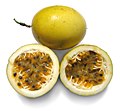Fruit flavor
| Fruit esters |
|---|

|
| R 1 and R 2 are organyl groups , e.g. B. alkyl groups . The ester group is marked in blue . |
The fruit aroma is a typical characteristic of various types of fruit . The aroma often consists of a large number of different compounds , a large proportion of which are called fruit esters . This refers to esters of short to medium-length carboxylic acids and alcohols . Lactones ( inner = cyclic esters) are occasionally found in fruit flavors. Other fruit flavors belong to the organochemical groups of alcohols, aldehydes or ketones .
The proportion of the aroma in the total weight of the fresh fruit is often less than 30 mg / kg. The main components of many fruit flavors are now commercially obtained from natural flavors and nature-identical flavors and are used to flavor a wide variety of foods and cosmetics.
Main components of various fruit flavors
Only the key flavorings are listed below.
pineapple
4-Hydroxy-2,5-dimethyl-3 (2 H ) -furanone ("HD3F", Furaneol ® ), ( S ) -2-methylbutyric acid ethyl ester and the like. a.
Apple
Essentially, esters , aldehydes and alcohols are involved in the apple aroma. The most important esters include 2-methylbutyric acid ethyl ester , butyric acid ethyl ester , acetic acid 2-methylbutyl ester , acetic acid n- butyl ester and acetic acid hexyl ester . Hexanal and ( E ) -2 are among the aldehydes, some of which only arise when chewing or chewing in the mouth through a very rapid enzymatic conversion of fatty acids and which are often referred to as green notes (taste of green apples, such as Granny Smith ) -Hexenal . In the case of alcohols, 1-butanol , 2-methylbutanol , 1-hexanol and ( E ) -2-hexen-1-ol are important. Other key flavors in apples are β- damascenone and α- farnese .
Apricot
( R ) - γ-decalactone , δ-decalactone , terpineol , geraniol , linalool , 2-methylbutyric acid
banana
Amyl acetate , 3-methylbutyl butyrate, 3-methylbutyl 3-methylbutyl ester
pear
Amyl acetate , (2 E , 4 Z ) -Deca-2,4-dienoic acid ethyl ester
blackberry
2-heptanol , terpineol, 1-hexanol, 2-heptanone
strawberry
4-Hydroxy-2,5-dimethyl-3 (2 H ) -furanone ("HD3F", Furaneol ® ), ( R ) -γ-decalactone, ( E ) -2-hexen-1-ol, ( E ) - 2-hexenal, acetic acid- ( E ) -2-hexen-1-yl ester, linalool, anthranilic acid methyl ester , butyric acid ethyl ester, hexanoic acid ethyl ester
The so-called "strawberry aldehyde" (not an aldehyde!) Ethyl methylphenyl glycidate or 2,3-epoxy-3-methyl-3-phenylpropanoic acid ethyl ester smells strongly of strawberries, but is not found in them.
Grapefruit
Main components in the juice: ( R ) -1- p- menthen-1-thiol ( thioterpineol ), but also butyric acid ethyl ester, ( Z ) -3-hexenal , 1-hepten-3-one, 4-mercapto-4-methylpentan-2 -on; in peel oil: (+) - nootkaton
raspberry
Raspberry ketone , but also α- / β- ionone and theaspiran
cherry
Benzaldehyde , hexanal , ( E ) -2-hexenal, phenylacetaldehyde , ( E , Z ) -Nona-2,6-dien-1-al, eugenol
kiwi
Main components in fresh kiwi fruit puree: 3-methyl-2-butanone, 3-hydroxy-2-butanone, ( E ) -2-hexenal, 3-hydroxybutyric acid ethyl ester , phenylethyl alcohol , α-terpineol, geraniol
tangerine
Thymol , N -methyl anthranilic acid methyl ester
melon
( Z ) -6-nonenal, 2,6-dimethyl-5-heptenal
orange
( R ) - Limonene , but also acetaldehyde , ( Z ) -3-hexenal, decanal , trans -4,5-epoxy- ( E ) -2-decenal
Orange Oil: neryl acetate (neryl acetate) and octyl acetate (octyl)
Passion fruit (maracuja)
The odor is determined by 2-methyl-4-propyl-1,3-oxathiane β- ionone , butyric acid ethyl ester , hexanoic acid ethyl ester, butyric acid hexyl ester , hexanoic acid hexyl ester
peach
Esters of acetic acid , lactones [e.g. B. ( R ) -γ-decalactone], hexanal, benzaldehyde and the like. a.
plum
Linalool , benzaldehyde, methyl cinnamate , ( R ) -γ-decalactone, C 6 aldehydes
quince
( E ) - / ( Z ) - Marmelolactone , α-Farnese, 2-methylbutyric acid ethyl ester, hexanol, 3-hydroxy-β-ionol and 5,6-dihydroxy-β-ionone
Blackcurrant
4-methoxy-2-methyl-2-butanethiol
lemon
Citral ( isomeric mixture of geranial / neral), but also linalool, myrcene and ( R ) -limons
Carboxylic acid ester occurrence in fruits (selection)
See also
literature
- YH Hui (Ed.): Handbook of fruit and vegetable flavors. Wiley, Hoboken 2010 ( limited preview in Google Book Search).
- ID Morton, AJ MacLeod: Food flavors. Part C: The flavor of fruits. Elsevier, Amsterdam a. a. 1990.
- DJ Rowe: Chemistry and technology of flavors and fragrances. Blackwell, Oxford et al. a. 2005 ( limited preview in Google Book Search).
Individual evidence
- ↑ a b c d e f H.-D. Belitz et al. a .: Textbook of food chemistry . 5th edition. Springer, Berlin a. a. 2001, pp. 821–825 ( limited preview in Google book search).
- ↑ a b c d e f Entry on fruit flavors. In: Römpp Online . Georg Thieme Verlag, accessed on March 26, 2016.
- ↑ a b c d e R. Ebermann, I. Elmadfa: Textbook food chemistry and nutrition . 2nd Edition. Springer, Vienna and New York 2011, pp. 420–425 ( limited preview in Google book search).
- ↑ MJ Jordán u. a .: Aroma active components in aqueous kiwi fruit essence and kiwi fruit puree by GC-MS and multidimensional GC / GC-O . In: J. Agric. Food Chem. 2002, 50, 5386-5390. PMID 12207479
- ↑ a b W. Legrum: Fragrances, between stench and fragrance . Vieweg + Teubner, Wiesbaden 2011, p. 88 ( limited preview in the Google book search).
- ↑ W. Ternes: Scientific basics of food preparation . 3. Edition. Behr's Verlag, Hamburg 2008, p. 824 ( limited preview in the Google book search).



















